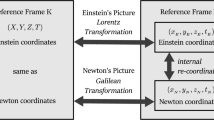Abstract
In the established space-time coordinate-transformation (STCT) interpretation of special relativity theory, relativistic changes are consequent upon the Lorentz transformation of coordinate clocks and rods between relatively moving systems. In the proposed alternative interpretation, relativistic changes occur only in association with physical interactions, and are direct alterations in the variables of the observed system. Since space-time and momentum-energy are conjugate four-vectors, transformation of a space or time variable of a system is to be expected only if there is a concomitant transformation of the corresponding momentum or energy variable. The Lorentz invariance of the scalar entropy functionS supports the interaction interpretation; timet=f(S) of a macroscopic, entropy clock should give a Lorentz-invariant time measure, and an illustrative entropy clock is discussed. Noninteracting physical processes may be called Clausius processes, in contrast to Lorentz processes for which there is interaction and associated Lorentz transformation. Changes of energy and frequency, withE=hv, are instances of the parallel relativistic transformations. Likewise, the variation with velocity in decay time of mesons follows directly from the relativistic energy transformation of decay products; this relationship is shown for muons by a simple calculation with β-decay theory.
Similar content being viewed by others
References
R. Schlegel,Time and the Physical World (Dover Publications, New York, 1968).
H. E. Ives and G. R. Stilwell,J. Opt. Soc. Am. 28, 215 (1938);31, 369 (1941).
G. Otting,Physik. Z. 40, 681 (1939).
B. D. Josephson,Phys. Rev. Letters 4, 341 (1960).
C. W. Sherwin,Phys. Rev. 120, 17 (1960).
W. Pauli,Theory of Relativity, transl. by G. Field (Pergamon Press, New York, 1958).
A. Einstein,Ann. Physik. 17, 891 (1905), secs. 7 and 8; English transl. by W. Perrett and G. B. Jeffery, inThe Principle of Relativity (Dover, New York), pp. 55–58.
James Terrell,Phys. Rev. 116, 1041 (1959); V. F. Weisskopf,Phys. Today 1960 (Sept.), 24–27.
M. Zemansky,Heat and Thermodynamics (McGraw-Hill, New York, 1943), p. 153.
L. A. Schmid, inA Critical Review of Thermodynamics, E. B. Stuart, B. Gal-Or, and A. J. Brainard, eds. (Mono Book Corp., Baltimore, 1970), pp. 177–202.
R. C. Tolman,Relativity, Thermodynamics, and Cosmology (Oxford Univ. Press, 1934), pp. 157–158.
C. K. Yuen,Am. J. Phys. 38, 246 (1970).
H. Minkowski, Space and time, inThe Principle of Relativity (Dover, New York), p. 87.
H. Goldstein,Classical Mechanics (Addison-Wesley, Reading, Mass., 1950), Sections 9–5 and 9–8.
H. A. Kramers,Quantum Mechanics, transl. by D. ter Haar (North-Holland, Amsterdam, 1957), p. 51.
C. Strachan,The Theory of Beta Decay (Pergamon, Oxford, 1969).
J. A. Eisele,Advan. Quantum Mechanics and Particle Physics, Vol. I (National Book Co., Washington, D. C., 1964), Chapter 3.
C. Møller,Kgl. Danske Videnskab. Selskab, Mat.-fys. Medd. 23, No. 1 (1945); reprinted inQuantum Scattering Theory, M. Ross, ed. (Indiana Univ. Press, Bloomington, 1963).
Author information
Authors and Affiliations
Rights and permissions
About this article
Cite this article
Schlegel, R. An interaction interpretation of special relativity theory. Part I. Found Phys 3, 169–184 (1973). https://doi.org/10.1007/BF00708437
Received:
Issue Date:
DOI: https://doi.org/10.1007/BF00708437




